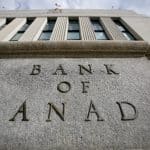
OTTAWA • Three years after the Bank of Canada froze borrowing costs, there is still no sign of a thaw.
As with other central banks, policymakers here have had to contend with a climate of economic uncertainty that many thought would have cleared long ago. But mild — and often unpredictable — growth, erratic employment data and tame inflation have kept the Bank of Canada’s trendsetting interest rate at the lowest level since the 1950s.
The last lending-rate rate change — by a quarter of a point to 1% — came in September 2010, when Canada had already climbed out of recession and cheap credit was expected encourage spending to keep that recovery chugging along. The outcome was not as planned, consumers piled up unsustainable debt, much of that in home purchases, while businesses have kept their cash close at hand until they see more consistent growth here and elsewhere, especially in the United States.
The lead architect of Canada’s monetary policy during and after the economic collapse, Mark Carney, is now in London and attempting to recast policy at the Bank of England — a far bigger challenge than he ever faced here.
His successor at the Bank of Canada, Stephen Poloz, has so far stayed the course set since becoming bank governor in June. And few project any change, any time soon.
Related
On Wednesday, Mr. Poloz and his policy team will again announce no change to their key overnight interest rate, a vehicle used to guide lending between commercial banks and nudge inflation towards the Bank of Canada’s 2% target. What could change is the wording of the statement, the so-called forward guidance that markets monitor closely for any hint of a policy shift.
For the new governor, who previously headed Export Development Canada but spent his early years at the central bank, it could be a chance to finally put a significant mark on that policy. Mr. Poloz has made just one speech since taking over from Mr. Carney, but his focus was very much on the business community, particularly exporters, which he stressed still needed to see concrete signs of recovery before cautiously providing long-awaited investment and hiring.
So far, economic data has remained “generally on the weak side,” said Charles St-Arnaud, an economist at Nomura International in New York, who previously worked at the Bank of Canada and the Finance Department.”But it has not been weak enough to suggest a change in the BoC’s view of the economy.”
Mr. Poloz’s first interest rate statement in July varied only slightly from previous ones, saying: “As long as there is significant slack in the Canadian economy, the inflation outlook remains muted, and imbalances in the household sector continue to evolve constructively, the considerable monetary policy stimulus currently in place will remain appropriate.”
The main difference in that guidance was it was “very wordy and slightly more confusing” than before, Mr. St-Arnaud said, but it did provide “further clarity as to what conditions are needed for them [policymakers] to consider normalizing rates.”
Still, with those conditions likely a long way off, most analysts do not anticipate any “normalizing” — as in an increase in the bank’s key rate — until at least the latter part of 2014.
By Gordon Isfeld, Financial Post
Photograph by: Galit Rodan/Bloomberg , Financial Post
© Copyright (c) National Post












